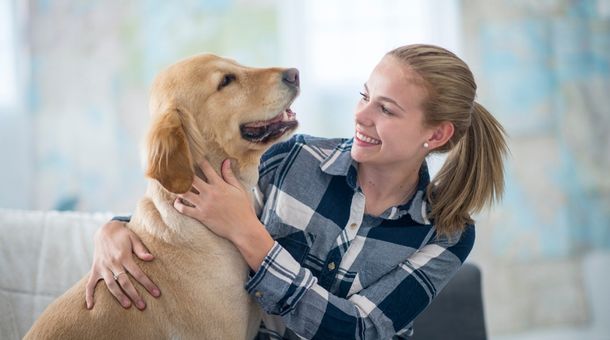Introduction: Why Understanding Your Pet’s Body Language is Important
Understanding your pet’s body language is crucial for effective communication and building a strong bond with your furry friend. While pets cannot speak our language, they communicate with us through their body language, which includes their facial expressions, body postures, vocalizations, and even their sense of smell. By learning to interpret and respond to these nonverbal cues, you can better understand your pet’s needs, emotions, and overall well-being.
The benefits of understanding your pet’s body language are numerous. Firstly, it allows you to provide the appropriate care and attention that your pet needs. For example, if your dog is displaying signs of fear or anxiety, you can take steps to alleviate their stress and create a safe environment for them. Secondly, understanding your pet’s body language can help prevent potential conflicts or accidents. By recognizing signs of aggression or fear in your pet, you can take proactive measures to avoid situations that may trigger negative behaviors. Lastly, understanding your pet’s body language can strengthen the bond between you and your furry companion. When you are able to respond appropriately to their needs and emotions, your pet will feel understood and loved, leading to a deeper connection between the two of you.
The Basics of Canine Body Language: What Your Dog is Trying to Tell You
Dogs have a wide range of body language cues that they use to communicate with humans and other animals. Understanding these cues can help you decipher what your dog is trying to tell you. For example, a wagging tail is often associated with happiness and excitement, but it can also indicate fear or aggression depending on the context and other accompanying behaviors. Similarly, a relaxed body posture with loose muscles and a soft expression usually indicates that your dog is calm and content, while a tense body posture with raised hackles and a fixed stare may indicate aggression or fear.
Dogs communicate with us through their behaviors and actions, and it’s important for us to understand what they’re trying to tell us. Barking is one of the most common behaviors that dogs exhibit, and it can have a variety of meanings. If your dog is barking excitedly, it may be because they want to play or are happy to see you. However, if your dog is barking excessively or in a high-pitched tone, it may be a sign of frustration or anxiety. Growling is another behavior that dogs use to communicate their emotions. If your dog is growling, it’s important to pay attention to their body language and the situation they’re in. If your dog is feeling threatened or uncomfortable, they may growl as a warning sign to let you know that they’re not comfortable with the situation. Whining is yet another behavior that dogs use to communicate their emotions. If your dog is whining, it could be because they’re anxious or excited, or they may simply be seeking attention from you. By paying attention to these behaviors and their accompanying cues, you can better understand your dog’s needs and emotions, which will help you build a stronger bond with your furry friend.
Decoding Feline Body Language: Understanding Your Cat’s Moods and Behaviors
Cats have a unique set of body language cues that they use to communicate with humans and other animals. Understanding these cues can help you decipher what your cat is trying to tell you. For example, a relaxed and content cat will have a loose body posture, with their tail held upright and slightly curved at the tip. On the other hand, a cat that is feeling threatened or defensive will have a tense body posture, with their tail puffed up and their ears flattened against their head.
Cats are known for their unique behaviors, and understanding what they mean is essential for any cat owner. Purring is one of the most common behaviors that cats exhibit, and it is often associated with contentment and relaxation. However, it is important to note that cats may also purr when they are in pain or feeling stressed. Therefore, it is essential to observe other cues such as body language to determine the reason behind the purring. Hissing is another common behavior that cats exhibit, and it is a clear sign of aggression or fear. When a cat hisses, it is a warning sign that they feel threatened or uncomfortable in their environment. It is important to give your cat space and avoid any actions that may trigger their hissing behavior. Meowing is a behavior that cats use to communicate various needs such as hunger, attention, or even illness. When a cat meows, it is essential to observe their body language and other cues to determine the reason behind the meowing. For instance, if your cat is meowing excessively and pacing around, it may indicate hunger or a need for attention. In conclusion, understanding your cat’s behaviors and their meanings is crucial for building a strong bond with your feline friend. By paying attention to their cues and responding appropriately, you can ensure that your cat’s needs are met and that they feel safe and comfortable in their environment.
The Importance of Eye Contact: What Your Pet’s Eyes are Saying
The eyes are often referred to as the windows to the soul, and this holds true for our pets as well. Your pet’s eyes can reveal a lot about their emotions and intentions. For example, dilated pupils in cats can indicate fear or excitement, while narrowed pupils can indicate aggression or discomfort. In dogs, direct eye contact can be seen as a challenge or a sign of dominance, while avoiding eye contact can indicate submission or fear.
When you maintain eye contact with your pet, you are communicating with them in a way that they can understand. This is especially important when trying to build trust and understanding between you and your furry friend. By looking into their eyes, you can show them that you are present and attentive to their needs, which can help to strengthen your bond over time. However, it is important to be aware that not all pets may feel comfortable with direct eye contact. Some animals may find it intimidating or threatening, especially if they have had negative experiences in the past. If your pet seems uncomfortable or avoids eye contact, it is best to approach them with a gentle and calm demeanor, and to respect their boundaries. In addition to maintaining eye contact, there are other ways that you can build trust and understanding with your pet. Spending quality time together, providing consistent care and attention, and using positive reinforcement techniques can all help to strengthen your bond over time. By working to establish a strong relationship with your pet, you can create a happy and healthy home environment for both of you.
Ears, Tail, and Posture: How Your Pet’s Body Position Reflects Their Emotions
In addition to their eyes, your pet’s ears, tail, and overall body posture can provide valuable insights into their emotions. For example, in dogs, erect and forward-facing ears usually indicate attentiveness and alertness, while flattened or backward-facing ears can indicate fear or submission. A wagging tail is often associated with happiness and excitement, but a tucked tail can indicate fear or anxiety.
Similarly, in cats, upright and forward-facing ears usually indicate curiosity or interest, while flattened or backward-facing ears can indicate fear or aggression. A relaxed and upright tail usually indicates contentment, while a puffed-up tail can indicate fear or aggression.
Understanding these different positions and what they mean can help you better understand your pet’s emotions and respond accordingly. For example, if your dog’s tail is tucked between their legs and their ears are flattened, it is a clear sign that they are feeling fearful or anxious. By recognizing these cues, you can take steps to alleviate their stress and create a safe environment for them.
Vocalizations: What Your Pet’s Sounds Mean and How to Respond
In addition to their body language, your pet’s vocalizations can also provide valuable insights into their emotions and needs. Dogs have a wide range of vocalizations, including barking, growling, whining, and howling. Each of these vocalizations can indicate different emotions or needs. For example, a high-pitched and repetitive bark can indicate excitement or the need for attention, while a deep and continuous growl can indicate aggression or the need for space.
Compared to dogs, cats have a more limited range of vocalizations. They typically communicate through meowing, purring, hissing, and yowling. Meowing is a common way for cats to communicate with humans and can indicate various needs such as hunger, attention, or even illness. It’s interesting to note that cats don’t meow to communicate with other cats, but rather use body language and scent marking. Purring is often associated with contentment and relaxation, and it’s a sound that many cat owners find soothing. Hissing and yowling, on the other hand, are clear signs of aggression or fear. These sounds are usually accompanied by other body language cues such as arched backs, flattened ears, and raised fur. It’s important for cat owners to understand their pet’s vocalizations and body language in order to better communicate with them and meet their needs.
By paying attention to these vocalizations and their accompanying cues, you can better understand your pet’s needs and emotions. For example, if your dog is barking excessively and pacing back and forth, it may indicate that they are feeling anxious or stressed. By recognizing these cues, you can take steps to alleviate their stress and provide the appropriate care and attention.
The Role of Smell: How Your Pet Uses Scent to Communicate
While we may rely heavily on verbal and nonverbal cues to communicate with our pets, they have an additional sense that plays a crucial role in their communication: their sense of smell. Dogs and cats have a highly developed sense of smell, which they use to gather information about their environment, other animals, and even humans.
Pets use scent to communicate a wide range of information, including their territory boundaries, their reproductive status, and even their emotional state. For example, dogs have scent glands in their paws, which they use to mark their territory and leave messages for other dogs. Cats have scent glands in their cheeks, which they use to mark objects and people as familiar and safe.
Understanding your pet’s sense of smell can help you better understand their needs and emotions. For example, if your dog is sniffing the ground and marking their territory, it may indicate that they are feeling confident and secure in their environment. By recognizing these cues, you can provide the appropriate care and attention that your pet needs.
The Power of Touch: How Your Pet’s Body Language Can Help You Bond
In the world of pet communication, touch is an essential element that cannot be overlooked. It is a powerful tool that pets use to convey their emotions and establish connections with their owners. Whether it’s a gentle nuzzle, a loving lick, or a playful paw, pets use touch to express their affection and seek comfort from their owners. Touch also helps pets establish social bonds with other animals, including humans. By using touch in a gentle and respectful manner, you can strengthen the bond between you and your pet. This can lead to a deeper understanding of your pet’s needs and desires, which can ultimately lead to a happier and healthier relationship between you and your furry friend. So, the next time you interact with your pet, remember the power of touch and use it to enhance your communication with them..
Touch can be used to communicate a wide range of emotions and needs. For example, a gentle pat on the head or a scratch behind the ears can indicate affection and approval. A gentle stroke along the back or belly can help calm an anxious or fearful pet. By using touch in a positive and nurturing way, you can create a sense of security and trust for your pet.
It is important to note that not all pets enjoy being touched in the same way. Some pets may be more sensitive to touch and may prefer gentle strokes or rubs, while others may enjoy more vigorous play and roughhousing. It is important to observe your pet’s body language and respond accordingly. If your pet shows signs of discomfort or stress, it is best to respect their boundaries and find alternative ways to bond with them.
Common Misunderstandings: Why We Misinterpret Our Pet’s Body Language
Despite our best efforts, it is common for pet owners to misinterpret their pet’s body language. This can lead to misunderstandings, conflicts, and even accidents. There are several reasons why we may misinterpret our pet’s body language.
Firstly, we may project our own emotions and intentions onto our pets. For example, if we are feeling sad or anxious, we may interpret our pet’s behavior as a reflection of our own emotions. It is important to remember that our pets have their own unique set of emotions and needs, and we should not assume that they are experiencing the same emotions as us.
Secondly, we may misinterpret our pet’s body language due to lack of knowledge or experience. Understanding pet body language requires observation, practice, and education. By learning about the common behaviors and cues of your specific pet species, you can better understand their needs and emotions.
Lastly, we may misinterpret our pet’s body language due to cultural or societal biases. For example, certain behaviors that are considered normal or acceptable in one culture may be seen as aggressive or inappropriate in another culture. It is important to approach pet communication with an open mind and to seek guidance from professionals or experienced pet owners if needed.
How to Improve Your Pet’s Body Language: Tips for Better Communication
Improving communication with your pet starts with observation and understanding. Here are some tips to help you better read and respond to your pet’s body language:
1. Observe: Take the time to observe your pet’s body language in different situations and contexts. Pay attention to their facial expressions, body postures, vocalizations, and even their sense of smell. By observing these cues, you can start to recognize patterns and understand what they mean.
2. Educate Yourself: Learn about the common behaviors and cues of your specific pet species. There are many resources available, including books, articles, and online forums, that can provide valuable insights into pet body language.
3. Seek Professional Guidance: If you are unsure about your pet’s behavior or if you are experiencing challenges in communication, it is always best to seek guidance from a professional. Veterinarians, animal behaviorists, and experienced trainers can provide valuable advice and support.
4. Use Positive Reinforcement: When your pet displays behaviors that you want to encourage, such as calmness or attentiveness, reward them with praise, treats, or playtime. This will reinforce the desired behaviors and strengthen the bond between you and your pet.
5. Respect Boundaries: It is important to respect your pet’s boundaries and to avoid forcing them into uncomfortable situations. If your pet shows signs of stress or discomfort, give them space and find alternative ways to meet their needs.
The Benefits of Understanding Your Pet’s Body Language: Improving Your Relationship
Understanding your pet’s body language can have numerous benefits for both you and your furry friend. Firstly, it allows you to provide the appropriate care and attention that your pet needs. By recognizing signs of fear, anxiety, or discomfort, you can take steps to alleviate their stress and create a safe environment for them.
Secondly, understanding your pet’s body language can help prevent potential conflicts or accidents. By recognizing signs of aggression or fear in your pet, you can take proactive measures to avoid situations that may trigger negative behaviors. This can help create a harmonious and safe environment for both you and your pet.
Lastly, understanding your pet’s body language can strengthen the bond between you and your furry companion. When you are able to respond appropriately to their needs and emotions, your pet will feel understood and loved. This can lead to a deeper connection and a more fulfilling relationship.
Conclusion: The Importance of Paying Attention to Your Pet’s Nonverbal Cues
In conclusion, understanding your pet’s body language is crucial for effective communication and building a strong bond with your furry friend. By learning to interpret and respond to their nonverbal cues, you can better understand their needs, emotions, and overall well-being.
The basics of canine and feline body language, the importance of eye contact, the significance of ears, tail, and posture, the meaning behind vocalizations, the role of scent, and the power of touch are all important aspects of pet communication. By paying attention to these nonverbal cues and responding appropriately, you can improve your relationship with your pet and create a harmonious and loving environment for both of you. So, next time you interact with your pet, take a moment to observe their body language and respond with love and understanding.




